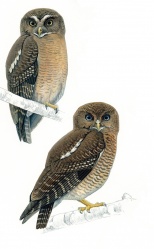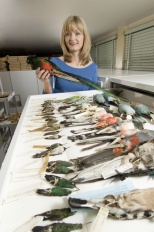EAST LANSING, Mich. — Two new species of owls have been discovered in the Philippines, and a Michigan State University researcher played a key role in confirming their existence.
“More than 15 years ago, we realized that new subspecies of Ninox hawk-owls existed in the Philippines,” Pam Rasmussen said. “But it wasn’t until last year that we obtained enough recordings that we could confirm that they were not just subspecies, but two new species of owls.”
The first owl, the Camiguin Hawk-owl, is found only on the small island of Camiguin Sur, close to northern Mindanao. At night, it gives a long solo song that builds in intensity, with a distinctive low growling tone. Pairs of owls give short barking duets that start with a growl. They also are the only owls to have blue-gray eyes.
The second new discovery was the Cebu Hawk-owl. Study of its structure and vocalizations confirmed that it was a new species. In fact, it was the unique calling or vocalizations of both owls that confirmed that the new classifications were warranted.
“The owls don’t learn their songs, which are genetically programmed in their DNA and are used to attract mates or defend their territory; so if they’re very different, they must be new species,” Rasmussen said. “When we first heard the songs of both owls, we were amazed because they were so distinctly different that we realized they were new species.”
The owls have avoided recognition as distinct species for so long because the group shows complex variation in appearance that had been poorly studied, and their songs were unknown. Both islands are off the beaten path for ornithologists and birders, who usually visit the larger islands that host more bird species.
Sound recordings of both new owl species and those from other islands are available free on AVoCet.
 |
(Top left: Cebu Hawk owl. Bottom right: Camiguin Hawk owl.) Courtesy of Oriental Bird Club: original painting by John Gale. |
“More than 15 years ago, we realized that new subspecies of Ninox hawk-owls existed in the Philippines,” Pam Rasmussen said. “But it wasn’t until last year that we obtained enough recordings that we could confirm that they were not just subspecies, but two new species of owls.”
The first owl, the Camiguin Hawk-owl, is found only on the small island of Camiguin Sur, close to northern Mindanao. At night, it gives a long solo song that builds in intensity, with a distinctive low growling tone. Pairs of owls give short barking duets that start with a growl. They also are the only owls to have blue-gray eyes.
The second new discovery was the Cebu Hawk-owl. Study of its structure and vocalizations confirmed that it was a new species. In fact, it was the unique calling or vocalizations of both owls that confirmed that the new classifications were warranted.
 |
Pam Rasmussen, MSU assistant professor of zoology and assistant curator of mammalogy and ornithology at the MSU Museum. Photo courtesy of MSU. |
The owls have avoided recognition as distinct species for so long because the group shows complex variation in appearance that had been poorly studied, and their songs were unknown. Both islands are off the beaten path for ornithologists and birders, who usually visit the larger islands that host more bird species.
Sound recordings of both new owl species and those from other islands are available free on AVoCet.
Category ›
Quick fun Facts
 Unknown
Unknown
 Saturday, August 18, 2012
Saturday, August 18, 2012










No comments:
Post a Comment